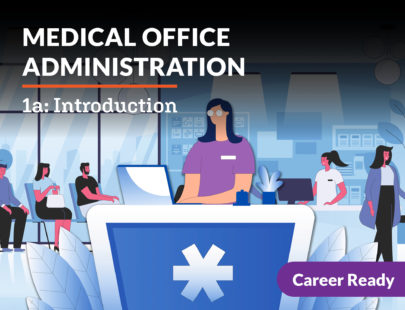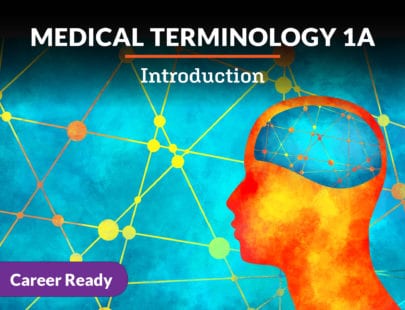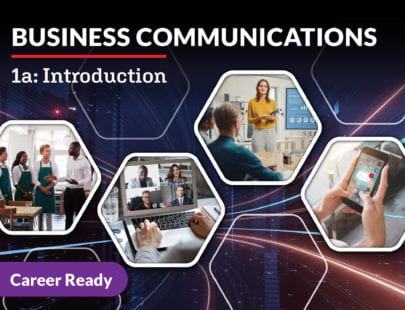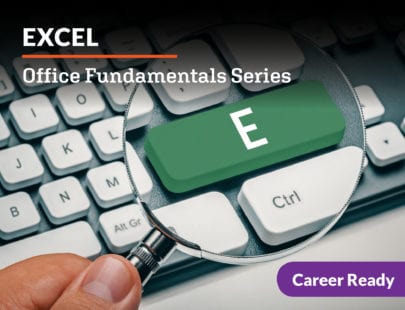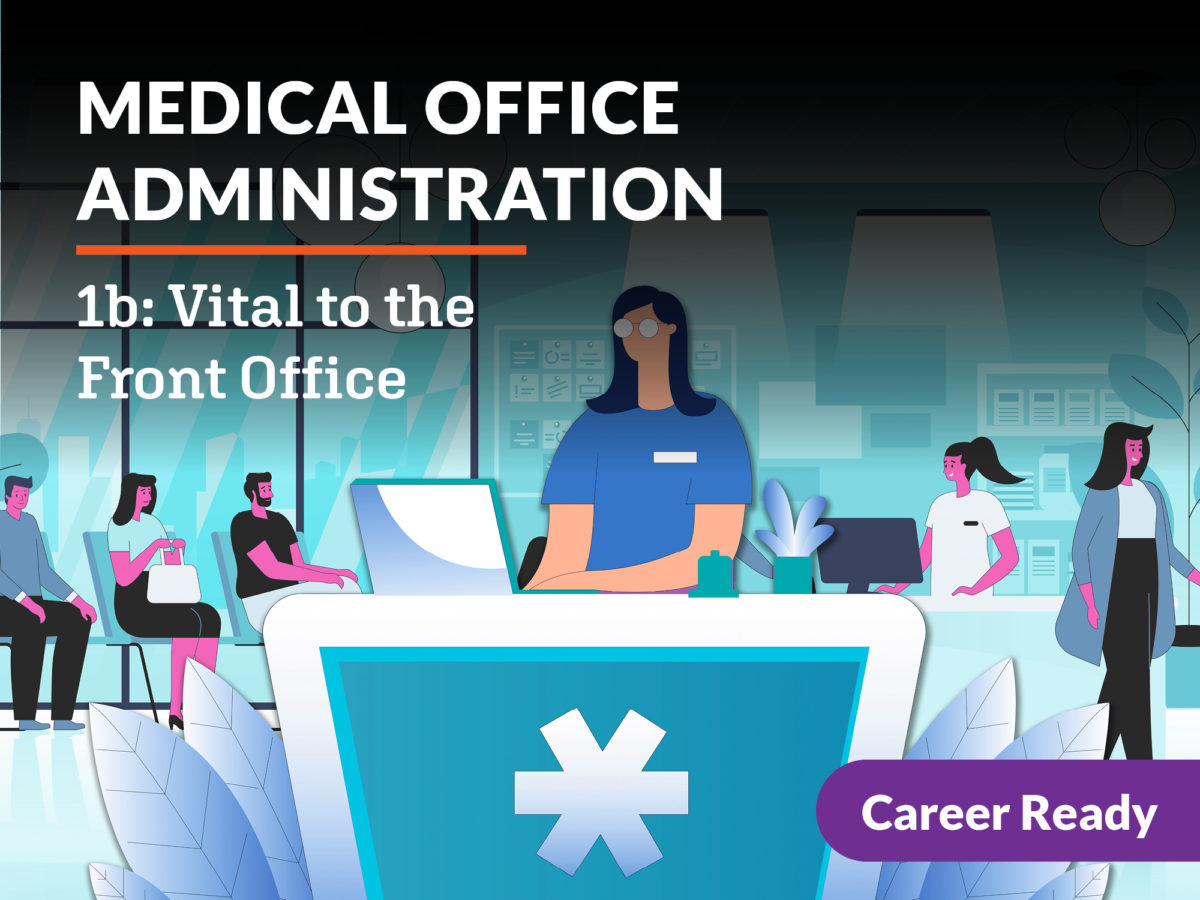
Medical Office Administration 1b: Vital to the Front Office
You have learned some of the basics of what it takes to become a successful medical office administrator, and now, it’s time to grow your understanding even further! In this course, you will complete a deeper dive about the variety of roles available in the medical office along with the skills needed to not only run the front of the office but to excel in the position as well. Finally, you’ll focus on you and how to apply all that you’ve learned to get your foot in the door to begin a career in medical office administration. Let’s get started!
Units at a Glance
Unit 1: Managing the Medical Office
Managing the medical office is no easy feat. A medical office manager must be familiar with each employee’s role and responsibilities, from entering new patient information to processing insurance claims. Management includes functions such as planning, organizing, directing, staffing, and controlling people and things. Office managers usually have college degrees, and they demonstrate a wide variety of skills to be able to effectively manage the office. They have many responsibilities and must be able to prioritize tasks and direct people. Good office managers are able to manage the office effectively and motivate their people in a way that encourages them to want to be a better employee and improve their work as they learn and gain more experience. Managing a medical office can be a most rewarding experience.
What will you learn in this unit?
- Define management
- List the characteristics and skills of the medical office manager
- Explain the benefits of certification
- Describe the responsibilities of the medical office manager
- Compare and contrast management and leadership
Unit 2: Medical Insurance, Coding, and Billing
Medical offices provide many types of medical services to patients, from routine physical exams to minor procedures. Someone must pay for these services and most often, payment is the patient’s responsibility. Most people don’t know if and when they may need medical services; therefore, in order to make sure they can pay for these services, they purchase medical insurance. Providers in medical offices agree to see and treat patients in exchange for payment. This payment is usually received from health insurance companies and/or the patient. If a patient does not have health insurance, they must cover the cost of any services themselves unless someone else is responsible for their payment. Medical offices must employ qualified personnel to manage their insurance, billing, and coding functions to ensure revenue is received and in a timely manner. These occupations offer individuals job security and a good income, and can lead to other, higher-paying billing and management positions.
What will you learn in this unit?
- Identify why people purchase insurance
- Describe the difference between private and government insurance programs
- List the steps in the medical billing process
- Explain fraud and abuse in medical billing
Unit 3: Medical Coding
Medical coding is the use of standardized codes that represent diagnoses, procedures, and other services in health care. All healthcare facilities must use these diagnosis and procedures (services) codes, and they are primarily used to bill insurance companies for reimbursement for medical services. The standardized code sets include the International Classification of Diseases (ICD), the Current Procedural Terminology (CPT), and the Healthcare Common Procedure Coding System (HCPCS). The purposes of medical codes are to show medical necessity, provide statistical analyses, receive reimbursement, and determine where to allocate resources. Medical offices employ at least one medical coder or designate someone who will be responsible for coding, and it’s that person’s responsibility to analyze medical records for documentation compliance, review codes for accuracy, and educate providers and staff on code changes. The financial success of the practice is impacted by the efficiency of their medical coding process and personnel.
What will you learn in this unit?
- Describe the code sets used in medical coding
- Identify the six steps in the medical coding process
- Explain the diagnosis and procedure coding processes
- Compare and contrast the CPC and CCS certifications
Unit 4: Healthcare Quality
Anyone considering a career in health care must understand the importance of providing quality health care to patients. Providing quality care includes many things, such as employing caring, professional, and knowledgeable people; developing and monitoring office processes and procedures; and asking patients about their care. These are only a few elements that promote the delivery of quality care. Quality care primarily depends on the providers. Providers such as physicians, nurse practitioners, and physician assistants have obtained the required education and training for their job, but they must also continue to maintain current knowledge in their field. From the receptionist to the provider, everyone in the office is responsible for providing quality care to their patients.
What will you learn in this unit?
- Define quality in health care
- Identify quality programs in the medical office
- Describe the types of data medical offices are required to collect and report
- List and explain methods for preventing a lawsuit
Unit 5: Patient Safety
Did you know millions of patients suffer from injuries or die because of unsafe or bad health care? The World Health Organization reported that globally, medication errors were a leading cause of injury in healthcare systems. Patients expect their providers and the medical office to deliver safe health care in a safe environment, and all employees in the medical office are responsible for patient safety. The office should have procedures in place—procedures that all employees know and follow to protect their patients. It is the responsibility of all healthcare providers to do what is necessary to promote and prevent patient safety. Failure to do so not only results in poor patient outcomes, but also increased costs and potential legal issues. Offices should promote a culture of patient safety so that employees are constantly aware of their role in providing safe health care.
What will you learn in this unit?
- Define patient safety in health care
- Identify organizations, laws, and standards that endorse patient safety
- Describe a culture of patient safety in the medical office
- Recognize examples of patient safety procedures in the medical office
Unit 6: Accounting Day to Day
Medical office staff perform a variety of accounting functions in the medical office. From the time the patient arrives for their appointment to the point where final payments are made, there are accounting procedures that must be followed to ensure an accurate accounting of money received and spent. Focus is on daily accounting procedures such as posting transactions, processing and submitting insurance claims, posting reimbursement from insurance companies, managing and collecting delinquent accounts, and creating reports. Most medical offices use computerized patient accounting systems as well as written policies and procedures to complete these daily accounting functions. Employees responsible for accounting tasks possess specific accounting skills and must be trained on the office’s accounting procedures. The profit and integrity of the practice depend on all employees understanding and adhering to respectable accounting practices.
What will you learn in this unit?
- Explain how services for insured patients are paid
- Define accounting and the four elements of accounting
- Illustrate the types of reports used in medical office accounting and how they are used
- Describe the career opportunities in insurance, billing, and coding
Unit 7: Accounting: The Bigger Picture
Healthcare facilities must focus on their finances in order to continue providing healthcare services, improve services, buy new equipment, train personnel, and make countless other improvements. Whether facilities are not-for-profit or for-profit, there must be someone—or even several people—in charge of the bigger picture. These are not the people entering daily charges and transactions. These are the office managers, providers, and other involved personnel who have a stake in the business. They are creating, reviewing, and analyzing financial reports on a regular basis in order to make informed decisions that will impact the financial success of the office. Individuals working in this field of health care must possess excellent organizational, problem-solving, mathematical, and critical thinking skills.
What will you learn in this unit?
- Explain the difference between day-to-day accounting and managerial accounting
- List four common accounting policies
- Describe the elements included in a simple budget
- Identify four types of medical office expenses
- Name the skills necessary for finance managers
Unit 8: Careers
Choosing a career might be a daunting task, but it is an exciting one as well. You are at a time in your life where so many things are possible. With so many career options, how do you decide? There are many ways to explore careers to determine the best one for you. Many students start working toward their career goals while in high school, which is why you are taking this course. Self-assessment questionnaires can help determine what you like to do and what you inherently do well. Interviewing and job shadowing professionals working in your potential field can also provide you with valuable information that only those working in the field can provide. Choosing a career takes time and effort, but the results are worth it.
What will you learn in this unit?
- Define career exploration
- Give examples of student clubs and the opportunities they provide
- Identify potential medical office careers
- Describe how to prepare for a mock job interview
Required Materials
Physical
- Video recording device
- Art supplies
- Digital camera
Software
- Word processing software
Other
- Reliable sources (print or online)
- Partner
Optional
- Printer
- Index cards
- Medical coding site
- Audio recording device
